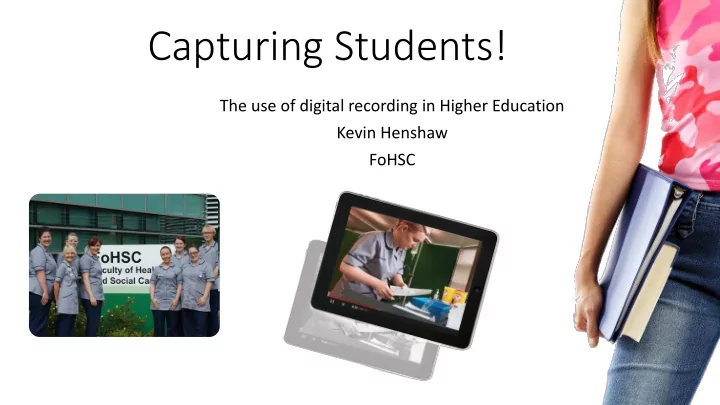

Capturing Students! The use of digital recording in Higher Education Kevin Henshaw FoHSC
Examples of Digital Technology • Talking Heads (Uskov 2005, Gladwell 2005) • Video and audio archive resources-on line libraries, AR • Animated screen shots-TechSmith, Camtasia and Macromedia Captivate to record and edit animated screenshots (Carl Simmons, CMIST) • Instructional 'how to videos‘ - BBC “Good Shooting Guide” (2005) negates need for linear narrative ie case studies • Interviewing an expert -Articulate, i Spring (Wallace and Donald, 2006)
• Video blogs 'think aloud‘ - informal personal reflection • Students create their own video - short videos by students for projects or portfolios i.e. group work, projects (Allam, 2006) • Videoing real events in situ – reflection, field trips, Presentation/performance skills and feedback Class watch (Millar, 2005, Strathie 2006 ) • Video case studies/simulations/role plays – Social Workers ‘ Clydestown ’ (West and Donald, 2006), experiment with different responses to behaviours, SIM, dangerous lab experiments
What about feedback? Does your assessment support your students’ learning ? (Gibbs & Simpson, 2004) Written feedback for students: too much, too detailed or too incomprehensible to be effective? (Glower, & Brown,2006) Writing, commenting and revising: The relationship between teacher feedback and student revision online. (Golstien & Kohls, 2002)
Why record? • Robust assessment • Aids quality assurance • Promotes active learning • Increases student engagement (Constructivist) • ‘Untapped pedagogical potential’ (Fee & Fee, 2003) • Can be ‘Constructively aligned’ (Biggs, 1996) • Experiential Learning (Vygotsky, 1934) • Contribute to an e-portfolio • Self assessment (student & Teacher) • Peer assessment (distance or F2F) • PDP development
WHY Not? • Difficult to control digital information • Non compliant students • Self consciousness • Hawthorne effect (Franke and Kaul,1978) • Data storage • Data protection • Equipment failure • Equipment availability • Teaching colleagues/protocols • Where in the curriculum ?
The set up:
What we did • Wanted to create a facility for formative assessment and feedback:
Feedback issues • Turn it in • Blackboard • E Share • YouTube • Camstudio • Group feedback
The Goal (Individual feedback) • Voice over with written feedback • Any platform • Formative & Summative • Viva Voce (audio only)
PANOPTO!!! • Simulated exercise • Lecture capture • Assignment advise (FAQs) • Written & Audio feedback
Learning and Teaching Strategy (EHU) • high-quality teaching and learning, tailored assessment , and guidance and support for students • keeping abreast of innovation in teaching , learning and assessment and systematic dissemination of good practice within the University • learning support that recognises the diverse needs of students (SpLD) • a strong emphasis on pastoral and academic support • regular observation of teaching • the expectation that new and existing teaching staff engage fully in professional development
What they said: • ‘Thank you that's brilliant., i had perfect access to the video this time, and i can see exactly where i went wrong. Its a good feedback system, and hopefully it will prevent me making the same mistakes again in the real osce exam .’ Student A • sorry I've only just got your email. I've just watched the video and it was very useful although I find it very embarrassing watching myself back! Hugely appreciated! Student B • I think the eshare video is a useful tool for learning. Continuing commentary would be useful throughout the scenario if there was anything which needed particular attention. Student C • So hard to watch yourself but really useful as I can see where I was going wrong and also I can write a reflection on my actions. Thank you Student D
Growth Industry • ‘ Plebgate ’ • Mark Duggan
References • ALLAM C (2006). Using filmmaking to teach students about Shakespeare, urban regeneration and other stuff, DIVERSE Conference, Glasgow, UK BBC2005. “ GoodShootingGuide ” http://www.bbctraining.com/onlineCourse.asp?tID=5914&cat=2781 (accessed 5 th January 2014) • • BIGGS, J. (1996). Enhancing teaching through constructive alignment. Higher education , 32 (3), 347-364. • DALE E (1969). Audio-visual methods in teaching . New York: Dryden • FEE S and FEE L (2003) Pedagogical approaches for the use of video . In C Crawford et al. (Eds) Proceedings of Society in Information Technology and Teacher Educattion International Conference 2003 (pp. 1407-1414) • BRICK, B. & HOLMES J. (2008). Using screen capture software for student feedback: towards a methodology. IADIS International Conference on Cognition and Exploratory Learning in the Digital Age , (CELDA). • FRANKE, R.H. & KAUL, J. D. (1978). The Hawthorne experiments: First statistical interpretation. American Sociological Review, 43 (5), 623-643. • GIBBS, G. & SIMPSON, C. (2004). Does your assessment support your students’ learning? Centre for Higher Education Practice, London: Open University Press. • GLOWER, C. & BROWN, E. (2006). Written feedback for students: too much, too detailed or too incomprehensible to be effective? Bioscience Education e-Journal , 7 . Available at http:// www.bioscience.heacademy.ac.uk/journal/vol7/beej-7-3.pdf (accessed 30 November 2015) • GOLSTIEN, L. & KOHLS, R. (2002). Writing, commenting and revising: The relationship between teacher feedback and student revision online. Paper presented at the American Association of Applied Linguistics Conference , 6 – 9 April 2002, Salt Lake City, Utah. • GLADWELL M (2005). Blink: the power of thinking without thinking , Allan Lane, London • MILLAR S M (2005). Video as process and product , Educause Quarterly, 2005, 58-61
References • STRATHI, C. (2006). Promoting Collaborative Learning and Development through Video Enhanced Reflective Practice (VERP) http://escalate.ac.uk/2363 (accessed 5th January2016) • USKOV, V. ( 2005). Technology for advanced e-learning, E-Learn Conference , Vancouver, Canada • VYGOTSKY, L. (1934). Thought and language. Cambridge, MA: MIT Press. • WALLACE, I. and DONALD, D. (2006). Project Pad: An open source, browser based video animation tool, DIVERSE Conference, Glasgow, UK • WEST, J. and DONALD, D. (2006) “ Clydetown ”: The use of audio and video resources within a virtual community learning resource , DIVERSE Conference, Glasgow, UK
Recommend
More recommend